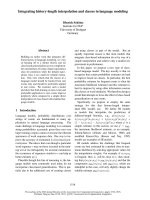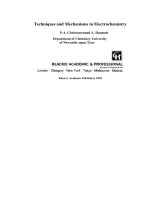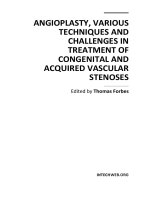Teaching methodology Techniques and Principles in Language Teaching
Bạn đang xem bản rút gọn của tài liệu. Xem và tải ngay bản đầy đủ của tài liệu tại đây (17.58 MB, 345 trang )
Course: Teaching Methodology
Book: Techniques and Principles in
Language Teaching
Author: Diana Larsen-Freeman
Second Edition, 12 chapters
Slide production: Dr. H. Iravani
Shahriar Center
Number of slides: 345
Language Teaching
Ten factors in each chapter
1. Teacher’s goals
2. Teacher’s role vs. students’ role
3. Features of teaching & learning
4. The nature of interaction
Language Teaching
5.
6.
7.
Dealing with students’ feelings
Language vs. culture
Language areas and skills to
emphasize
8. The role of the native
language
Language Teaching
9. Dealing with evaluation
10.Dealing with students’ errors
Two types of exercises:
checking your understanding
and applying what you studied
Language
Teaching:GT
Grammar Translation (GT) is the
first method we discuss.
GT appeared in the first half of
the 19th century and was one of
the nonscientific methods.
Language
Teaching:GT
Why is GT a classical method?
GT was to help students
appreciate L2 literature.
L2 grammar helps them learn Ll
grammar & grow mentally.
Language
Teaching:GT
Thinking about the experience
GT- a teacher proof method- in
Iran. It is the output of German
scholarship.
Language
Teaching:GT
Principles
1. Learning to read L2 literature
– written language is superior
to spoken language. L2
culture was literature and fine
arts.
Language
Teaching:GT
2. Translation from L2 to L1 and
vise versa: a central goal
3. Communication:not emphasized
4. Reading and writing: superior
5. Authority and fussy corrections
Language
Teaching:GT
6. L1 equivalents for L2 words
7. L1/ L2 similarities: emphasized
8. Form superior to content
9. Deduction over Induction
10. L2 learning: a mental exercise
Language
Teaching:GT
11. Explicit and conscious
knowledge of L2 Grammar
12. Memorization of grammatical
paradigms
Language
Teaching:GT
Summary
Reviewing the principles
Reviewing the techniques
Language
Teaching:GT
Activity:
Explain the differences between
learning about L2 and learning
to use L2.
Language
Teaching:GT
GT was challenged by:
1. Natural methodologists
2. Linguists interested in
phonetics
3. The reform movement
Language
Teaching:GT
Natural method gave rise to the
Direct method – the next
chapter. However, GT still has
its own proponents and is used
in some parts of the world.
Why?
Language
Teaching:DM
The Direct Method (DM) rose to
prominence at the beginning of
the 20th century and it is one of
the nonscientific methods,
similar to Grammar Translation.
Language
Teaching:DM
DM is a movement toward a
scientific method. Gouin
started a method based on
child language acquisition.
Language
Teaching:DM
Franke wrote on the direct
association between form and
meaning.
Saussure made a distinction
between language and
substance.
Language
Teaching:DM
To Saussure language is form
not substance.
In addition, Sauveur banned
translation and use of mother
tongue in the classroom.
Language
Teaching:DM
The weaknesses of GT made DM
very popular.
Basic principle:The use of L1 is
sin and the connection
between L2 and meaning
should be direct.
Language
Teaching:DM
Principles
1. Language is mainly speech.
Culture includes more than
fine arts. Reading is taught
from the beginning.
Language
Teaching:DM
2. Concrete objects are used to
make the direct link between
form (language) and meaning.
3. Mother tongue has almost no
role.
Language
Teaching:DM
4. Demonstration is preferred to
explanation and translation.
5. Vocabulary in use is
emphasized to boost thinking
in English. (Real use in real
sentences)
Language
Teaching:DM
6. Oral communication is the
goal.
7. Pronunciation receives primary
attention - focus on form.
8. Self correction is preferred to
teacher’s correction.
Language
Teaching:DM
9. Lessons should provide the
chances for real life
conversation.
10. Grammar is taught
inductively or implicitly.









